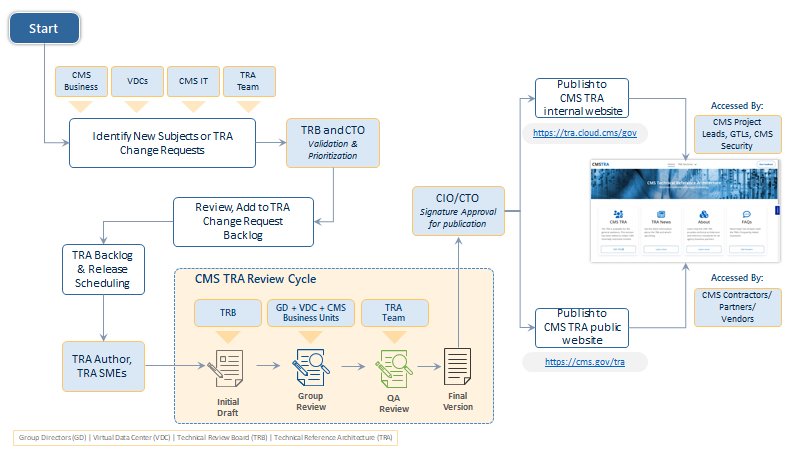The ACR Process establishes the standard CMS process for request, review, approval, and publication of changes to the CMS TRA. The ACR Process consists of the major activities as shown in Architecture Change Request (ACR) Process and below. The CMS TRA is accessible via the TRA websites. The complete version of the TRA is provided via an internal TRA website https://tra.cloud.cms.gov that is accessible to CMS employees and contractors with CMS network access. A public version is available to anyone at https://cms.gov/tra. The public version has CMS sensitive information redacted. Information about the CMS Target Life Cycle (TLC), often referenced in conjunction with the CMS TRA, is accessible at: https://www.cms.gov/Research-Statistics-Data-and-Systems/CMS-Information-Technology/TLC/index.

Request for Change
CMS employees submit requests for changes to the CMS TRA using an Architecture Change Request (ACR) Form that is delivered to the Division of IT Investment Management and Policy (DIIMP) via an email to the CMS IT_Governance@cms.hhs.gov mailbox. CMS Contractor partners and/or other employees who identify the need for an Architectural Change should request their Government Task Lead or other CMS employee submit a change request on the contractor’s behalf.
Review and Prioritization
The CTO and TRB reviews submitted ACRs to determine how they will be addressed and either closes the request or schedules the change request for processing.
Reasons for closing a change request at this point include, but are not limited to:
-
Duplicate requests
-
Out-of-scope activities (e.g., production implementation steps)
-
Lack of information to support any actions taken on behalf of the request
Proposed Updates to the TRA
Based on input from the CTO, the TRA Release Coordinator works with subject matter experts (SME) to identify changes to the CMS TRA to incorporate into an upcoming release. The TRA Release Coordinator ensures that all selected ACRs are addressed with the stakeholders and SMEs and coordinates the appropriate changes across all impacted parts of the CMS TRA.
TRA Release Review – Initial TRB Consult
When the proposed updates are completed, the TRA Release Coordinator submits the revised TRA to the TRB for initial review and schedules a TRB consult to discuss the proposed changes. The TRA Release Coordinator then updates the release based on TRB Consult comments and feedback received during the review period. Some comments may be addressed by creating a new ACR to be assigned to a future release.
TRA Release Review – Group Review
The TRA Release Coordinator submits the release for review by CMS Group Directors, CMS Business Units, and CMS data center operators for review and comment. The TRA Release Coordinator then updates the release based on comments and feedback received during the review period. Some comments may be addressed by creating a new ACR to be assigned to a future release.
CIO / CTO Review and Signature
After the TRB and Group reviews are completed and all comments are addressed, the TRA Release Coordinator submits the release to the CIO and CTO for review, approval, and signature. If the CIO or CTO have any comments, the TRA Release Coordinator addresses the comments and resubmits the release for final review and approval. After all CIO / CTO comments have been addressed, the CIO and CTO sign the release.
Release Publication
After the CIO and CTO sign the release, the TRA Release Coordinator publishes the updated CMS TRA. As prescribed in BR-F-2, The CMS TRA Applies to All CMS Processing Environments, the latest published CMS TRA applies immediately for new systems; for existing systems, compliance with CMS TRA updates is required within twenty-four (24) months of publication.